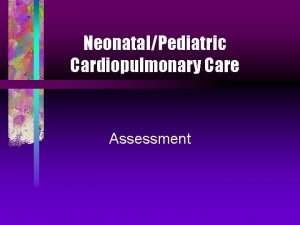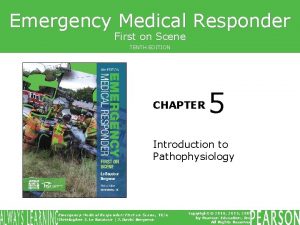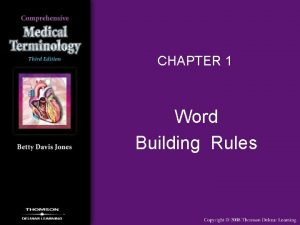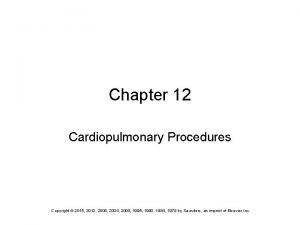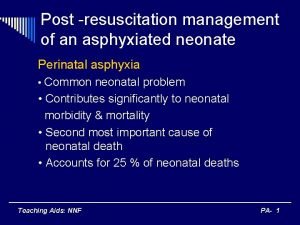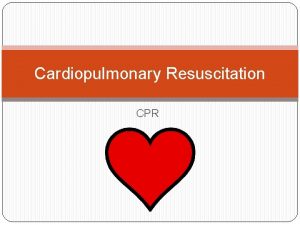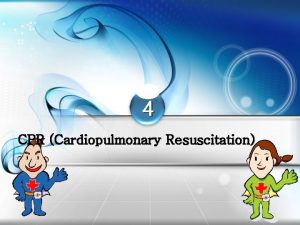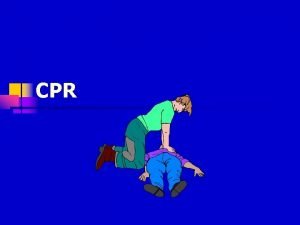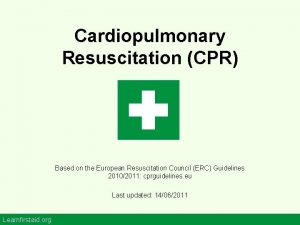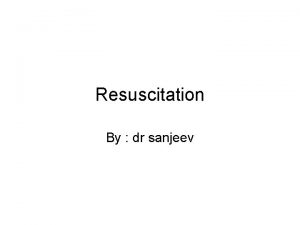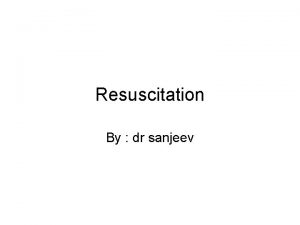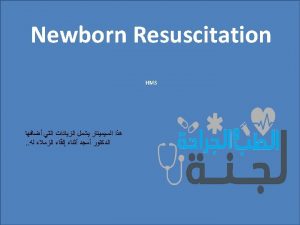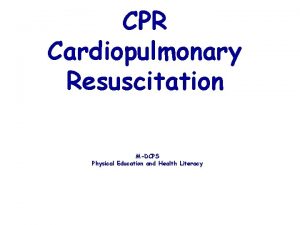Cardiopulmonary Resuscitation CPR What is CPR Cardiopulmonary resuscitation











- Slides: 11

Cardiopulmonary Resuscitation CPR

What is CPR? Cardiopulmonary resuscitation (CPR) is a lifesaving technique useful in many emergencies, including heart attack or near drowning, in which someone's breathing or heartbeat has stopped. What does CPR stand for? Cardiopulmonary Resuscitation Cardio = Heart Pulmonary = Lungs Resuscitation = To Bring Back

What causes the heart to stop? �Heart Attack �Drowning �Electrocution �Suffocation

CPR Steps 1. Check the scene for safety. 2. If the scene is safe, approach the victim, tap on their shoulder and shout: Are you ok? 3. If there is no response, call 911 or yell for someone to call 911.

CPR Steps 4. Look, listen & feel for breathing. While victim is laying on their back, kneel beside them. Then: A) Tilt their head back with one hand. B)With your other hand, place your index finger and middle finger on their carotid artery (neck). C) Put your ear next to the victims mouth. (You should be looking down towards

CPR Steps 5. If the victim is NOT breathing: A) Place the heel of on of your hands on the victim’s breast bone. B) Place your other hand on top of the first hand interlock your fingers. C) While keeping your elbows straight and only the heel of your hand on the victim’s chest, begin 100 compressions. *When doing chest compressions, you should depress the victims chest approximately 2 inches.

CPR Steps 6. After you do 100 chest compressions, look listen and feel for breathing again. - If the victim is still not breathing, do another 100 chest compressions. Keep repeating the chest compressions and checking for breathing. *If the victim becomes conscious (wakes up) at any point during chest compressions, stop the compressions immediately. **Even if the victim wakes up, stay with them

Rescue Breaths �After you look listen and feel for breathing, tilt the head back, pinch the nose and perform 2 slow rescue breathes. �After the 2 rescue breaths, perform 30 chest compressions. �After the 30 chest compressions, do 2 more rescue breathes and keep repeating the cycle. *After 5 cycles, look listen and feel for breathing again. ** 1 cycle = 2 rescue breathes and 30 chest

Warm up How should a burn be treated?

First Aid & Safety Treating Burns Bruises – Fractures – Sprains Insect Bites

First Aid & Safety Click here to find out what should be in a first aid kit
 Chapter 17:11 providing first aid for sudden illness
Chapter 17:11 providing first aid for sudden illness Resuscitation cpr
Resuscitation cpr Cpr tutorial
Cpr tutorial Cardiopulmonary
Cardiopulmonary Emergency medical responder first on scene 10th edition
Emergency medical responder first on scene 10th edition Megalocardia word parts
Megalocardia word parts Chapter 27 cardiopulmonary procedures
Chapter 27 cardiopulmonary procedures Lung blood supply
Lung blood supply Management of asphyxia neonatorum after resuscitation
Management of asphyxia neonatorum after resuscitation Pediatric color-coded length-based resuscitation tape pdf
Pediatric color-coded length-based resuscitation tape pdf Difference between resuscitation and resurrection
Difference between resuscitation and resurrection Mount vernon formula
Mount vernon formula



